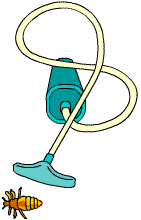Pediculosis
Created | Updated Nov 29, 2010

Pediculosis, or the affliction of head lice, results from tiny, wingless bugs of 2 - 3mm1, in length, with flat, elongated bodies infesting the scalp hair of a human victim. The lice have six legs with tiny claws and live only on human scalps. They can range in colour from light brown to grey.
Contrary to popular conception2, head lice are not a sign of uncleanliness. Anyone can get head lice under the right conditions, but they are most commonly found in primary school aged children. Lice can infest anyone: young, old, rich, poor, clean or dirty.
Lice like to lay their eggs, or nits, behind the ears, on the back of the head above the neck, and on the top of the head. Adult lice may be found anywhere on the head.
There are several ways you can know the tiny specks on your head are nits:-
Nits are hard to remove from your hair, and they feel like little grains of sand.
Unlike nits, dandruff can be easily flicked away with your finger.
Nits are tiny and yellowish-white. Dandruff is larger and white.
Life Cycle
When a female louse finds its way onto the head of a person, she starts laying eggs, or nits, along with a glue that firmly attaches the nits to the hair close to the scalp. In a week or so, the nits hatch. A hatched nit needs a human blood meal within 45 minutes to survive.
It takes about ten days for a newborn louse, or nymph, to become an adult. Once an adult, the female louse can start laying eggs. Female adults can live from seven to ten days and will produce five eggs per day during this time.
How they Spread
Lice are spread through head to head contact and the sharing of such items as combs, brushes, clothing and bedding. They cannot live on pets, or away from a human host for longer than 48 hours. Lice do not fly or jump; they can only crawl.
Symptoms
Itching is the most common symptom of a head lice infestation and may occur two or three weeks after infestation, but children with a light infestation may not show any symptoms at all. Therefore, if lice are suspected to be present, a thorough examination of the hair and scalp is necessary.
Treatment

The most reliable way to get rid of the bug is the hard way: to methodically and manually remove all live lice, dead lice and nits.
Thoroughly eliminating lice includes removing lice and nits from the household environment by vacuuming, washing or freezing objects suspected of being infested, and then conducting daily head checks and nit removal until infestation is gone, followed by weekly head checks to detect reinfestation.
Nit removal
This is easiest to do for children while the child is in the bath, as any lice that slide out of the hair can be washed straight down the plug hole at the end of treatment.
You will need:
A pot of very hot water for sterilising
A good nit comb (preferably metal)
Hair clips to pin up the sections of hair that have been combed
Shampoo the hair and rinse it. Smother the hair with conditioner, then comb the hair using a regular comb to remove knots.
Starting at the crown of the child's head, separate out a section of hair that is about 2cm3 wide, and hold it out from the head. Insert the louse comb at the base of the hair section as close as possible to the scalp, and pull the comb slowly through the hair. Rinse the comb in the boiling water. Continue to comb the section of hair until you feel sure it is free of nits or lice, then pin it out of the way with a hair clip and start on the next section of hair. When all the hair has been combed, rinse it thoroughly with water and then dry. After the hair is completely dry, check the entire head for stray nits and remove them individually.
There are also many shampoos and lotions readily available from pharmacies to help you extricate the lice. Also, if your child is infested, tell the school - this will stop the lice from spreading any further.

